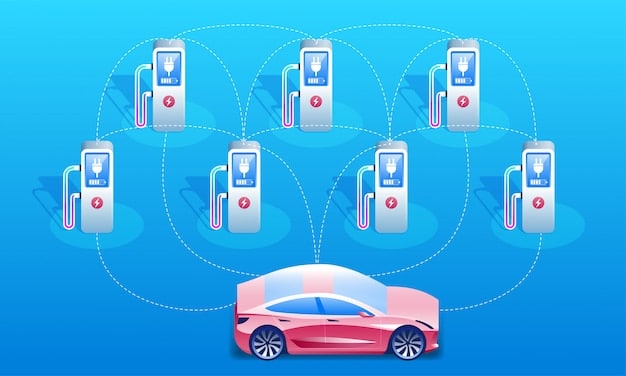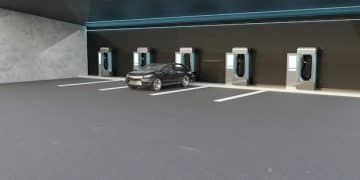Electric Vehicle Grid Integration: Smart Charging for a Stable US Grid

Electric vehicle grid integration leverages smart charging technology to stabilize the US power grid by optimizing energy demand and reducing costs, enabling efficient management of electricity flow between EVs and the grid.
As electric vehicles (EVs) become increasingly prevalent, understanding their impact on the power grid is crucial. Electric vehicle grid integration, particularly through smart charging technology, offers a promising solution to stabilize the US power grid while reducing energy costs.
Understanding Electric Vehicle Grid Integration
Electric vehicle grid integration refers to the process of connecting EVs to the power grid in a way that allows for bidirectional energy flow and optimized management. This integration is vital for ensuring that the growing number of EVs doesn’t destabilize the grid, but instead contributes to its efficiency and reliability.
The core of EV grid integration lies in smart charging technology. Smart charging enables EVs to charge during off-peak hours when electricity demand is low and energy is cheaper. It also allows the grid to draw energy from EVs during peak demand, effectively using EVs as mobile energy storage units.

The Role of Smart Charging
Smart charging plays a pivotal role in successful EV grid integration. It goes beyond simply plugging in an EV to charge. It involves sophisticated communication and control systems that allow the grid operator and the EV owner to manage charging schedules and energy flow.
- Off-Peak Charging: EVs can be programmed to charge automatically during off-peak hours, reducing strain on the grid during peak times.
- Demand Response: EVs can participate in demand response programs, where they charge less or even discharge energy back to the grid during peak demand events.
- Grid Stabilization: By providing ancillary services like frequency regulation, EVs can help stabilize the grid and prevent blackouts.
By implementing smart charging strategies, utilities can better manage energy demand, reduce the need for costly infrastructure upgrades, and even lower electricity prices for consumers.
In conclusion, understanding the fundamentals of electric vehicle grid integration and the role of smart charging is the first step toward realizing the full potential of EVs as a resource for grid stability and cost reduction.
Benefits of Smart Charging for the US Power Grid
Smart charging technologies offer a multitude of benefits for the US power grid. These advantages range from enhanced grid stability to reduced energy costs and improved utilization of renewable energy sources.
One of the primary benefits is the ability to balance energy supply and demand. By shifting EV charging to off-peak hours, utilities can avoid overloading the grid during peak demand times. This helps prevent blackouts and brownouts and ensures a more reliable power supply for all consumers.
Enhanced Grid Stability
Grid stability is crucial for maintaining a consistent and reliable power supply. Fluctuations in energy demand can lead to voltage drops and frequency deviations, which can damage equipment and even cause widespread outages.
- Frequency Regulation: EVs can respond quickly to changes in grid frequency, injecting or absorbing energy as needed to maintain stability.
- Voltage Support: Smart charging can provide voltage support by adjusting the reactive power drawn from the grid.
- Reduced Congestion: By spreading out EV charging over time, smart charging can alleviate congestion on transmission and distribution lines.
Smart charging can also improve the integration of renewable energy sources like solar and wind. These sources are intermittent, meaning their output varies depending on weather conditions. EVs can store excess renewable energy when it’s available and discharge it back to the grid when needed, helping to smooth out the variability.

Overall, the benefits of smart charging extend far beyond individual EV owners. By enhancing grid stability, reducing energy costs, and promoting the use of renewable energy, smart charging can help build a more resilient and sustainable energy future for the United States.
Challenges and Barriers to EV Grid Integration
While the potential benefits of EV grid integration are significant, there are several challenges and barriers that need to be addressed to ensure its widespread adoption. These challenges range from technical issues to regulatory hurdles and consumer acceptance.
One of the main technical challenges is the need for advanced communication and control infrastructure. Smart charging requires real-time data exchange between EVs, charging stations, and the grid operator. This necessitates the deployment of sophisticated communication networks and control systems.
Technical and Regulatory Hurdles
Implementing EV grid integration involves overcoming a number of technical and regulatory obstacles. These hurdles can slow down the deployment of smart charging infrastructure and hinder the realization of its full potential.
Without subtitiles or lists for this part of the section.
One crucial aspect is the establishment of standardized communication protocols. Currently, there are several different protocols used for smart charging, which can create interoperability issues. Adopting a universal standard would facilitate seamless communication between different EV models and charging stations.
Another challenge is ensuring data security and privacy. As EVs become more integrated with the grid, they will generate vast amounts of data about charging habits and energy usage. Protecting this data from unauthorized access and misuse is essential for maintaining consumer trust.
From a regulatory perspective, utilities need to develop rate structures that incentivize smart charging. Time-of-use rates, which charge different prices for electricity depending on the time of day, can encourage EV owners to charge during off-peak hours. However, these rates need to be carefully designed to ensure fairness and avoid penalizing EV owners.
Consumers also need to be educated about the benefits of smart charging and its role in supporting a stable and affordable power grid. Addressing these challenges and barriers is crucial for unlocking the full potential of EV grid integration and creating a more sustainable energy future.
In summary, although EV grid integration and smart charging offer many advantages, tackling the technical and regulatory obstacles is paramount for successful implementation and widespread acceptance.
Smart Charging Technologies and Standards
To effectively integrate electric vehicles into the power grid, it’s essential to understand the various smart charging technologies and standards that enable this integration. These technologies and standards facilitate communication, control, and energy management between EVs and the grid.
Several different charging levels and standards exist. Level 1 charging uses a standard household outlet (120V), while Level 2 charging uses a higher voltage (240V) and requires a dedicated charging station. DC fast charging (Level 3) provides the fastest charging speeds but requires specialized equipment and infrastructure.
Overview of Charging Standards
Having a clear understanding of the charging standards is crucial for ensuring compatibility and interoperability between different EVs and charging stations.
- SAE J1772: This standard defines the connector and communication protocols for Level 1 and Level 2 charging in North America.
- CHAdeMO: This standard is primarily used for DC fast charging and is popular in Japan.
- CCS (Combined Charging System): This standard combines the SAE J1772 connector with DC fast charging capabilities, making it a versatile option for both Level 2 and Level 3 charging.
These technologies and standards are crucial for ensuring that EVs can seamlessly connect to the grid, participate in demand response programs, and contribute to grid stability. Additionally, they help facilitate advancements in how renewable energy sources are utilized.
In conclusion, understanding these technologies and standards is essential for anyone involved in the EV industry, from manufacturers and utilities to policymakers and consumers.
Policy and Incentives Supporting EV Grid Integration
Government policies and incentives play a critical role in accelerating the adoption of EV grid integration technologies. These initiatives can help overcome market barriers, stimulate investment, and promote consumer adoption.
Several states and municipalities have implemented policies to support EV adoption and grid integration. These policies often include financial incentives, such as tax credits and rebates, for purchasing EVs and installing charging stations. They may also include regulatory measures, such as mandates for utilities to develop smart charging programs.
Government Initiatives and Consumer Incentives
Government initiatives and consumer incentives are essential for driving the adoption of EV grid integration and promoting a sustainable transportation future.
Without list or subtitles for this part of the section.
At the federal level, the Inflation Reduction Act of 2022 includes several provisions aimed at supporting EV adoption and clean energy technologies. These provisions include tax credits for purchasing new and used EVs, as well as incentives for installing EV charging infrastructure.
Some states have also adopted zero-emission vehicle (ZEV) mandates, which require automakers to sell a certain percentage of EVs in their states. These mandates can help drive innovation and increase the availability of EVs in the market.
In addition to financial incentives, governments can also support EV grid integration through public awareness campaigns and education programs. These initiatives can help educate consumers about the benefits of EVs and smart charging, as well as address any misconceptions or concerns they may have.
By creating a supportive policy environment, governments can help accelerate the transition to a cleaner and more sustainable transportation system, while also ensuring that the power grid remains stable and reliable.
Ultimately, thoughtful policies and effective incentives are vital for maximizing the benefits of EV grid integration and fostering a greener energy ecosystem.
Future Trends in Electric Vehicle Grid Integration
The field of electric vehicle grid integration is constantly evolving, with new technologies and approaches emerging all the time. Looking ahead, several key trends are expected to shape the future of EV grid integration.
One of the most promising trends is the development of vehicle-to-grid (V2G) technology. V2G allows EVs to not only draw energy from the grid but also discharge energy back to the grid. This bidirectional energy flow can provide valuable ancillary services, such as frequency regulation and voltage support.
Emerging Technologies and Innovations
The future of electric vehicle grid integration is bright, with several emerging technologies and innovations promising to transform the way we manage energy and transportation.
- Wireless Charging: Wireless charging technology is becoming more prevalent providing a more convenient charging experience.
- Blockchain Technology: Using blockchain may enhance security and transparency.
- AI and Machine Learning: AI can be used to optimize charging schedules based on real-time grid conditions and individual driver behavior.
These advancements are expected to make EV grid integration more efficient, reliable, and cost-effective. They will also enable EVs to play a more active role in supporting a cleaner and more resilient power grid.
In conclusion, the future of electric vehicle grid integration is full of exciting possibilities. By embracing new technologies and approaches, we can unlock the full potential of EVs as a resource for grid stability and sustainability.
| Key Point | Brief Description |
|---|---|
| ⚡ Smart Charging | Optimizes EV charging times to reduce grid strain. |
| 💡 Grid Stability | EV integration supports stable grid operation. |
| 💰 Cost Reduction | Reduces energy costs to the consumer. |
| ♻️ Renewable Energy | Better incorporation for renewable sources. |
Frequently Asked Questions
▼
Electric vehicle grid integration connects EVs to the power grid for managing energy flow, improving grid stability, and optimizing costs.
▼
Smart charging optimizes EV charging times, distributes demand, and enhances grid management, ensuring stability and reduced strain.
▼
Technical hurdles for EV grid integration include standardization, infrastructure advancements, and ensuring data security and interoperability.
▼
Tax credits, rebates, and regulatory measures that promote smart charging programs can assist greatly in boosting EV grid Integration efforts.
▼
Future trends anticipate increased use of AI, V2G technology, and wireless charging to drive efficiency, grid stability, and overall cost reduction.
Conclusion
Electric vehicle grid integration, powered by smart charging technology, represents a transformative opportunity to stabilize the US power grid, lower energy costs, and usher in a more sustainable energy landscape for future generations.





